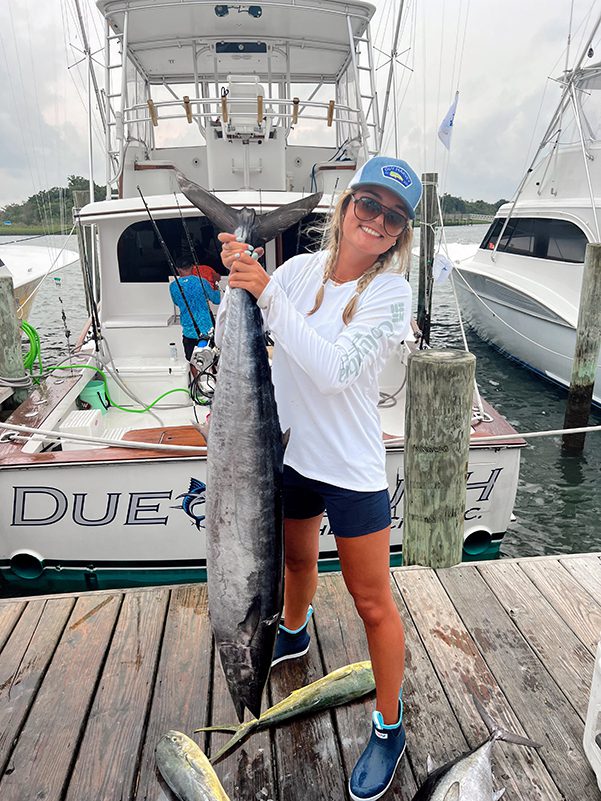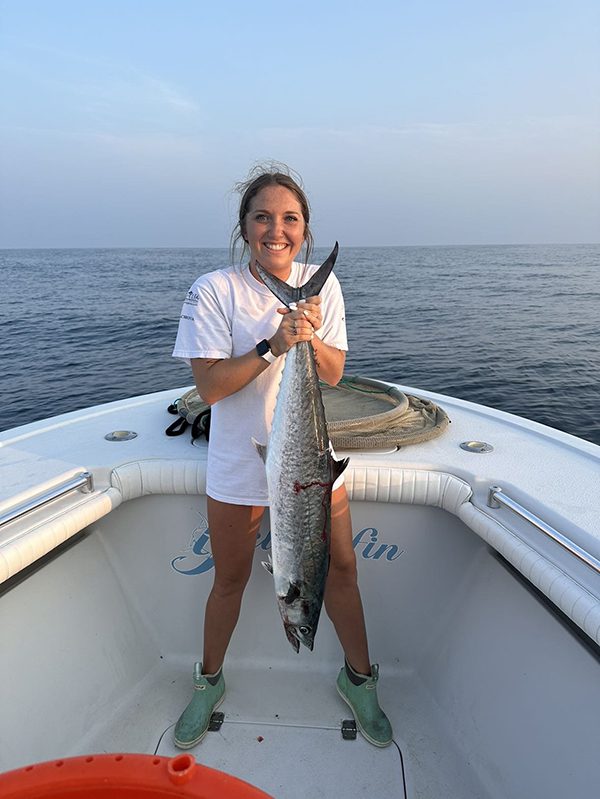Morehead City/Atlantic Beach – August 2023
Hunter, of Chasin’ Tails, reports that the red drum are scattered anywhere and everywhere. Natural baits work best with water temperatures up where they are, and any variety of live finger mullet, cut mullet, cut pogies, or live shrimp can entice a strike. Target these reds up on marsh flats as tides rise, and then look in nearby deeper holes or channels when it drops out.
Some random speckled trout are sprinkled in the deeper holes. Live shrimp is about the only bait to target trout with in summer conditions.
Areas of hard structure are holding black drum for anglers fishing shrimp (cut or live) on the bottom.
Sheepshead fishing has picked up in the area.
Nearshore anglers have been finding plenty of spanish mackerel from the beachfronts to out over the nearshore reefs. Getting deeper has also produced some good-sized king mackerel.
The hard bottom structures out around 10 miles are holding large barracuda and amberjacks, and the deeper bottoms (out in 80’+) are producing grouper, vermilion snapper, and triggerfish.
The Gulf Stream trolling action has been generating mixed results, but at times some wahoo are being caught alongside scattered mahi.
Billfish action has been excellent, with sailfish one of the better bites right now.
Back in the surf zone, anglers out on the beach are still seeing schools of bluefish and spanish mackerel move in around the inlet (and during times of lesser beach-goer traffic). Bottom fishing the surf has produced some pompano (close to citation-sized) and sea mullet.
Joe, of Carolina Traditions Guide Co., reports that inshore anglers have started seeing some good sheepshead and black drum action around area bridges and hard structures.
Flounder have been really plentiful both in the backwaters and out on the nearshore reefs. Any live baits fished on the bottom around structures have worked in enticing strikes.
The red drum bite has been a bit hit or miss. The best action is in the early mornings and late evenings, with tide flow being very important across either time period. These groups of reds are very oriented to the backwater structures, with oyster beds, grass beds, and flats all being good areas to start fishing efforts.
A few speckled trout can be found once you find bait, but the bite is only very early (around sunrise).
Nearshore action has seen a nice class of spanish mackerel while live baiting around the ARs.

Madison Craig, of Winston-Salem, NC, hooked this 41 lb. wahoo on ballyhoo. She was fishing 50 miles offshore of Morehead City with Capt. Mark Chambers, on Due South.
Daniel, of On Deck Fishing Charters, reports that red drum have been making a good showing back in the marshes. Anglers are having the most success fishing live shrimp or cut shad under corks. Topwater plugs are also producing some strikes.
Nearshore action has included a bunch of spanish mackerel off the beach, and running around and looking for bird action is a great way to find these schools. Plenty of bluefish are mixed in around the spanish.
Anglers have had some success live-baiting over the nearshore ARs. This tactic has produced citation-sized spanish mackerel, king mackerel, and barracuda.
Chris, of Mount Maker Charters, reports that inshore anglers are still finding good numbers of quality speckled trout and mixed red drum in the ICW, rivers, and creeks. Live bait has produced most of the action, except in the early mornings when anglers enjoy throwing topwater plugs.
Nearshore trips are seeing good numbers of spanish mackerel and bluefish. Throwing casting jigs is the preferred method, but at times finicky fish can require trolling spoons behind #0 or #1 planers.
A fairly consistent king mackerel bite has been happening for those fishing live baits. The kings have been over nearshore reefs and near the inlet.
Getting further off the beach, bottom fishing in the 75-140’ range remains strong. Anglers are finding a nice mixed bag of gag grouper, hind grouper, and some nice scamps. Also in the mix are the prevalent vermilion snapper, triggerfish, porgies, grunts, and amberjacks.
A fair number of nearshore dolphin and even sailfish are around.
Justin, of Breakday Charters, reports that nearshore runs are still seeing plenty of spanish mackerel and bluefish in the inlet and out along the beaches. Some of the larger spanish have been found a bit deeper.
King mackerel are around, but most have been further off the beach with the higher water temperatures.
Bottom fishing remains a strong option for anglers looking for action. Grouper, vermilion snapper, nice-sized black sea bass, and amberjacks are all a part of the catch.
Inshore anglers have been doing well targeting slot red drum and scattered speckled trout along the deeper marsh banks. With water temperatures where they are, fishing natural baits is a key to success.
Byron, of Going Bogue Outdoors, reports that the mid-summer trolling bite can be a little hit or miss, with fish so scattered due to high water temperatures.
Bottom fishing action remains strong, including a successful keeper American red snapper season. Hopefully these efforts can help the gag grouper thrive a little moving through summer and into fall.
The bottom is also filled with vermilion snapper, triggerfish, and the occasional cobia.

Riley Kearny, of Cape Carteret, hooked this 15 lb. king mackerel using live menhaden. She was fishing 15 miles out of Bouge Inlet in 65’ of water.
Cody, of Reel Time Charters, reports that the wahoo bite has been uncharacteristically good, especially during the new and full moon cycles. Most of the action has been anywhere in the 30-60 fathom range.
Anglers have been having a blast catching sailfish, with a few white and blue marlin mixed in. Getting into the 100 fathoms area is best for targeting this bite.
Dolphin fishing has been a bit slow, with the hot water temperatures having fish scattered.
Bottom fishing has also been a bit hit or miss. Gag grouper action in the shallower (60-70’) areas has been the best bet.
Bri, of Oceanana Pier, reports that anglers fishing live baits have landed some quality spanish mackerel (to 5+ lbs.), with the clean water being a big factor in how good the bite has been. Casting Gotcha plugs is producing bluefish and the smaller-medium class of spanish.
Those out on the planks either really early or late have caught some speckled trout (to 8 lbs.) with live shrimp.
Bottom fishing has produced sea mullet, flounder (releases), spot, and croakers.





